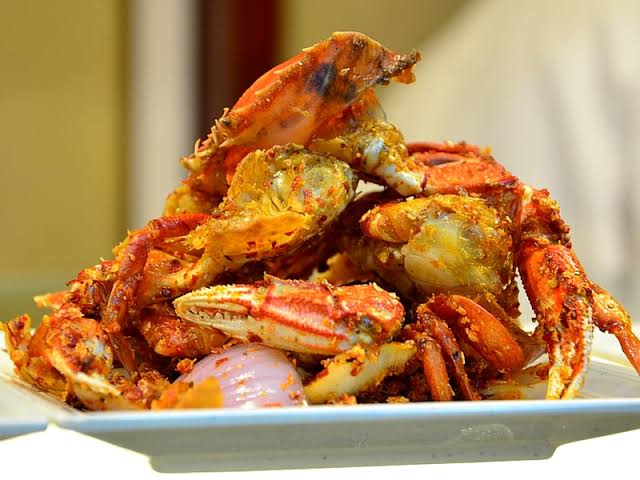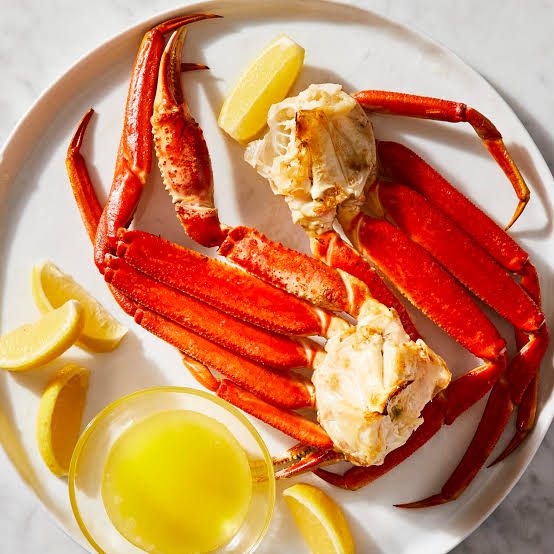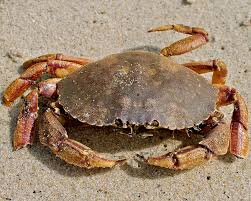Crabs are a type of crustacean with a hard exoskeleton and two large pincers. They are found in oceans, freshwater lakes, and rivers all over the world, and come in many different shapes, sizes, and colors.
Crabs are omnivores, which means they eat both plants and animals. They have a specialized digestive system that allows them to extract nutrients from a wide variety of food sources, including algae, mollusks, and other small sea creatures.
Crabs play an important role in many marine ecosystems as both predators and prey. They are also a popular seafood, and are often boiled or steamed and served with butter and other seasonings.
In some cultures, crabs are considered to be a symbol of good luck and prosperity, while in others they are associated with danger and aggression. Overall, these fascinating creatures are an important part of the world’s oceans and waterways.
Read Also: Tillage Implements and Implements for Seed Bed Preparations
Description of Crab

Crabs have a distinctive appearance with a hard, external exoskeleton that protects their body. They have two large claws, called chelae, which they use for defense and for capturing prey. These claws can vary in size and shape depending on the species of crab. In addition to their claws, crabs have eight legs, with the first pair often modified into smaller appendages called chelicerae or maxillipeds, which they use to handle food.
Crabs come in a variety of sizes, with some species being as small as a few millimeters and others reaching sizes of over 12 feet across. They also come in many different colors, ranging from brown and green to bright blue, red, and even purple.
Most crabs have compound eyes, which are made up of many individual lenses that allow them to see in multiple directions. They also have a pair of antennae that they use to sense their environment and communicate with other crabs.
Additionally, crabs have a unique and fascinating appearance that has helped them to adapt to a wide variety of environments and become a successful group of animals.
Health Benefits of Crab

Good source of protein: Crab is a good source of high-quality protein, which is essential for the growth and repair of the body’s tissues.
Rich in vitamins and minerals: Crab is rich in vitamins and minerals, such as vitamin B12, vitamin C, zinc, selenium, and copper, which are important for maintaining good health.
Low in fat: Crab is low in fat and calories, making it a healthy option for those who are watching their weight.
Improves bone health: The high levels of calcium, phosphorus, and vitamin D in crab are beneficial for improving bone health.
Boosts immunity: Crab contains antioxidants, which help to boost the immune system and protect the body against diseases.
Helps with wound healing: The high levels of protein and zinc in crab are beneficial for wound healing and tissue repair.
Good for the heart: The omega-3 fatty acids in crab help to lower the risk of heart disease by reducing inflammation and improving cholesterol levels.
Regulates blood pressure: The potassium in crab helps to regulate blood pressure and reduce the risk of hypertension.
Helps with digestion: The high fiber content in crab is beneficial for digestion and can help to relieve constipation.
Reduces inflammation: The antioxidants and omega-3 fatty acids in crab have anti-inflammatory properties that can help to reduce inflammation in the body.
Improves brain function: The omega-3 fatty acids in crab are beneficial for brain health and can improve cognitive function.
Supports thyroid function: The high levels of iodine in crab are beneficial for thyroid function.
Reduces the risk of cancer: The antioxidants in crab can help to reduce the risk of cancer by protecting the body against free radical damage.
Improves vision: The vitamin A in crab is beneficial for vision and can help to prevent age-related macular degeneration.
Good for the skin: The zinc in crab is beneficial for skin health and can help to prevent acne and other skin conditions.
Reduces the risk of anemia: The high levels of iron in crab can help to prevent anemia by promoting the production of red blood cells.
Helps with insomnia: The high levels of magnesium in crab can help to promote relaxation and improve sleep quality.
Boosts energy levels: The high levels of B vitamins in crab can help to boost energy levels and reduce fatigue.
Promotes muscle growth: The high levels of protein in crab are beneficial for muscle growth and can help to improve athletic performance.
Uses of Crab

Crab Cakes: Crab cakes are a popular appetizer or main course that are made with crab meat, breadcrumbs, eggs, and seasonings. They are typically pan-fried or baked and served with a dipping sauce.
Crab Soup: Crab soup is a delicious and warming soup made with crab meat, vegetables, and broth. It can be made in a variety of styles, such as Maryland-style crab soup or spicy Thai crab soup.
Crab Salad: Crab salad is a refreshing and light dish made with crab meat, mayonnaise, and various seasonings. It can be served on its own or as a filling for sandwiches or wraps.
Crab Boil: Crab boil is a classic seafood dish where a variety of seafood, including crabs, are boiled in a seasoned broth with potatoes, corn, and other vegetables. It is typically served with melted butter and lemon wedges.
Crab Dip: Crab dip is a creamy and savory dip made with crab meat, cream cheese, sour cream, and various seasonings. It can be served with crackers, chips, or vegetables.
Crab Rolls: Crab rolls are a variation of the popular lobster roll, where crab meat is used instead of lobster. The crab meat is mixed with mayonnaise, celery, and seasonings, and served on a toasted roll.
Crab Curry: Crab curry is a spicy and flavorful dish made with crab meat, coconut milk, and a variety of spices. It is typically served with rice or bread.
Crab Sushi: Crab is a popular ingredient in sushi, where it is typically used as a filling for rolls or as a topping for nigiri sushi. It pairs well with avocado, cucumber, and other vegetables.
Crab Stuffed Mushrooms: Crab stuffed mushrooms are a delicious appetizer made with crab meat, mushrooms, breadcrumbs, and various seasonings. They are typically baked until golden and served hot.
Crab Linguine: Crab linguine is a pasta dish made with crab meat, linguine, garlic, olive oil, and parsley. It is a simple and flavorful dish that is perfect for a quick and easy meal.
Read Also: Guide on Palm Kernel Oil Processing, Health Benefits and Uses
Anatomy of Crabs
Below is a brief overview of the anatomy of crabs:
Carapace: The carapace is the hard outer shell covering the crab’s body. It protects the internal organs and is often decorated with patterns and colors to help the crab blend into its surroundings.
Abdomen: The abdomen is the rear part of the crab’s body, and it contains the digestive, reproductive, and excretory systems.
Legs: Crabs have 10 legs, which are attached to their thorax. The front two legs have pincers, or chelae, that are used for defense and capturing food.
Eyes: Crabs have two compound eyes that are situated on stalks on the top of their carapace. They have excellent vision and can see in many directions at once.
Mouthparts: Crabs have a mouth located at the front of their body, and they have specialized mouthparts for crushing and grinding their food.
Gills: Crabs breathe through gills, which are located on either side of their body. The gills extract oxygen from the water and expel carbon dioxide.
Digestive system: The digestive system of crabs includes the stomach, intestine, and anus. They are omnivores and eat a wide range of foods, including algae, mollusks, and small fish.
Reproductive system: Crabs have separate sexes, and the males have specialized reproductive organs called gonopods. The females have a broad abdomen that contains the eggs, which are fertilized by the male during mating.
Overall, the anatomy of crabs is highly adapted to their marine environment, enabling them to move quickly and capture their prey with precision.
Read Also: How Environmental Education Can Inspire Clean Habits and Behaviors


I find it convenient how crabs are known to improve your muscles while making it easier for someone to relax and sleep. I have a colleague who wants to try different types of food as a new diet. I should talk to them about finding a seafood restaurant that serves these in the future.
Thank you so much and we are glad that you find our article very helpful